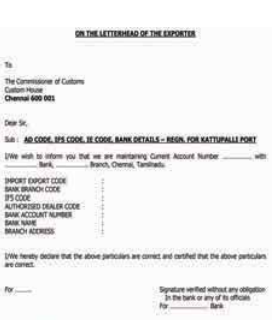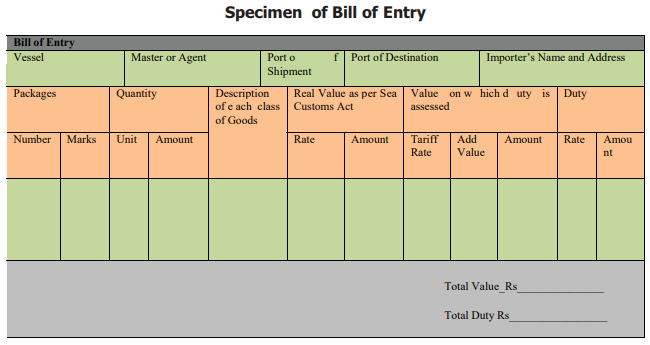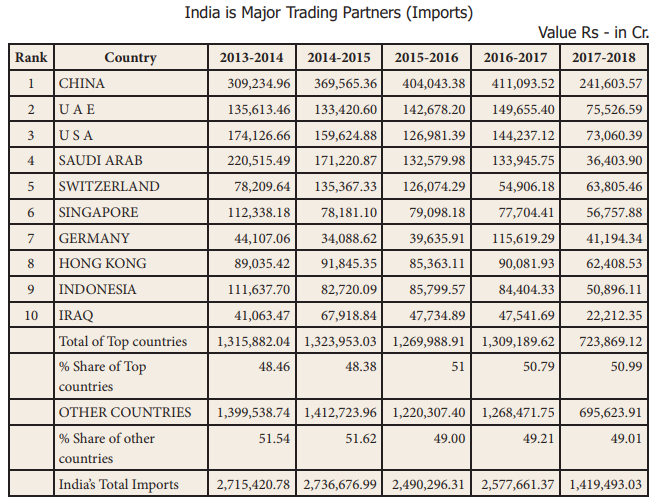Chapter: 11th Commerce : Chapter 26 : Export and Import Procedures
Import Procedure
Import Procedure
Import procedure varies from country to country depending upon the foreign trade policy of a country. Government of India has framed rules and regulations for the import. The import procedures has been clearly spelt out of Government of India. Following are the procedures of import trade.
1. Obtaining Import License
Importer has to secure Import and Export Code (IEC) from the Director General of Foreign Trade or its Regional Authority. The Indian Institute classification (ITC)–Harmonized System (HS) classified the goods into three categories, namely Restricted, Canalised and Prohibited. Goods not specified in the above categories can be freely imported without any restrictions. Import license is not required to import the goods not mentioned in the above classification. An import license is valid for 24 months for capital goods and 18 months for other goods.

Importer has to submit the copy of IEC to customs authorities at the time of clearance of goods. The second copy of IEC is used to obtain foreign exchange from RBI.
2. Trade Enquiry
Having obtained IEC, the intending importer has to make enquiry from exporter or his agents. Importer makes request by e-mail or postal mail to supply the details given below.
a. Specification of goods like size, design, quality etc.,
b. Quantity goods available
c. Price per unit
d. Terms of shipping
e. Terms of payments i.e. Letter of credit Documents against Acceptance (D/A)or Documents against Payment (D/P)
f. Probable delivery time
g. Validity of offer period
Importer responds to enquiry by sending proforma invoice
3. Obtaining Foreign Exchange
Since importer has to settle import bills in foreign currency, he has to obtain foreign exchange. Importer has to provide IEC code in the form supplied by authorized dealer to get foreign exchange.. The importer has to submit an application along with necessary documents to the Exchange Control Department of RBI. After scrutinising the said application, the Reserve Bank of India will sanction the release of foreign exchange.
4. Placing an Indent Order
Importer places an order either directly or through an indent houses. The indent contains the details like type of goods, design of goods, price, quantity, grade, packing instructions, insurance, delivery mode, desired delivery period, mode of period, mode of shipment, etc.,
5. Opening Letter of Credit(L/C)
Where foreign exporter does not know Indian importer, he may like to ensure the creditworthiness of the unknown importer. In such a case, exporter may advise the importer to arrange for letter of credit in his favour..Letter of credit is a document under which issuing bank undertakes to make payment on behalf of the importer or to the order of importer in exchange for specified documents from exporters bank. The letter of credit is issued only for financially sound importer. Exporter’s bank eventually sends the document to issuing bank which releases the payment.
6. Receiving Shipping Document
The importer collects shipping documents along with the advice note of shipment of goods from the exporters. Advice note contains a written message through which exporter informs the importer about the dispatch of goods and advise him to make agreement for taking delivery of goods on arrival of goods at the port of destination. The captain of the ship informs the dock authorities about the arrival of goods on a document called Import General Manifest. The customs authorities in turn inform the importer concerned about the arrival of goods at the port.
7. Appointment of Clearing Agents
There are lot of formalities involved in clearing the goods imported from the port. Normally importer does not feel comfortable with completing the formalities by himself. In this case he may delegate the task of clearing the imported goods from the port of discharge to clearing agent who is well-versed in this job. The latter performs the job for a fee. The importer sends all the documents to the clearing agent to enable him to take delivery of goods after fulfilling the customs formalities prescribed in this regard.
8. Fulfillment of Customs Formalities
Clearing agent engaged by the importer performs the following activities in connection with taking delivery of goods from the port.
i. Getting Endorsement for Delivery
The clearing agent gets bill of lading endorsed by importer in his favour to enable him to take delivery of goods and approaches the shipping company. Where the freight is not paid, the clearing agent pays it. The shipping company may give a separate delivery order after collecting the freight charges or it may simply endorse on the bill of lading by the importer or by his agent itself as a proof payment of freight charges.
ii. Payment of Dock Dues
The clearing agent submits two copies of filled in Application form to “Landing and Shipping Dues Office. This office levies charges on all the imported goods. The clearing agent has to pay Dock charges by Dock challan. After paying dock charges ‘Landing and Shipping Due Office stamps on the application form itself with wordings like Dock charges paid’ or it may issue a separate receipt called Post Trust Dues Receipt.
iii. Preparation of Bill of Entry
Bill of Entry is prepared in triplicate in order to pay custom duty. This document contains the details like name and address of importer, the name of the ship, full description of the goods, number of packages, importer and exporter code (IEC) name of the exporting country and custom duty payable. Bill of Entry is issued in three colours. The black form is meant for non-dutiable goods while the blue form is meant for the goods within the country and the violet is intended for re-export. Import duty is calculated on the basis of details given in the bill of entry by customs authorities. Where the importer / clearing agent does not know

He would provide as much as details possible about the goods imported to the extent of his memory and with specific remark that he cannot give complete information about the goods imported. In such a case , customs authorities will complete the statement and import duty only after assessing the arrival of goods at the port of delivery.
iv. Payment of Import Duty
The clearing agent / importer submits the bill of entry and other required documents to the customs authorities. He pays import duty in the case of dutiable goods to the customs authorities.
v. Release Order From Dock
After payment of customs duty, the bill of entry has to be marked by the dock. Superintendent and an examiner are instructed to physically examine the goods. He gives his report on the bill of entry. Then the bill is passed over to the port authority. He would issue release order.
vi. Getting Delivery From The Dock.
The clearing agent takes delivery of goods from the dock after submitting the documents like, Port Trust Dues Receipt, Bill of Entry and Bill of Lading. If the goods are imported for re-export, the agent / importer will deposit them in a bonded warehouse and receives Dock Warrant.
vii. Dispatching Goods to the Importer
The agent despatches the goods to the importer by the rail/ road. He gets Railway Receipt (R/R) or Lorry Receipt (L/R) from the transporter.
viii. Sending Advice to the Importer
Clearing agent informs the despatch of goods to the importer and sends Railway Receipt / Lorry Receipt with the statements of expenses incurred by him and the commission payable to him for his service.
9. Taking Delivery of Goods
Importer takes delivery of goods from the Railway /Carrier after producing the Railway Receipt or Lorry Receipt.
10. Settlement of Import Bill
The importer settles the import bill in the following ways.
a. Importer collects shipping document after payment
b. Importer gets shipping documents after payment of bills of exchange in the case of Documents against payments (D/P)
c. Importer gets shipping documents after giving acceptance on bills of exchange in the case of Documents against Acceptance(D/A)
Documents used in import trade
1.Import License (IEC)
2.Indent
3. Letter of Credit
Import Documents
· Import License
· Indent
· Letter of Credit
· Bill of Entry
· Bill of sight
· Port Trust Dues Receipt
· Bill Of Lading
· Bill of Exchange
· Advice Note

Related Topics